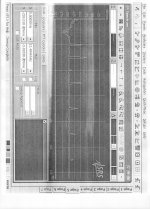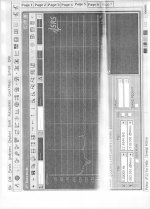Scott and Ed
Please read section 1.2 (book page 2) through end of section 1.6 (book page 18).
I think you’ll find some common ground
https://ia600208.us.archive.org/11/items/antennastheorypr00sche/antennastheorypr00sche.pdf
George
Please read section 1.2 (book page 2) through end of section 1.6 (book page 18).
I think you’ll find some common ground
https://ia600208.us.archive.org/11/items/antennastheorypr00sche/antennastheorypr00sche.pdf
George
Scott and Ed
Please read section 1.2 (book page 2) through end of section 1.6 (book page 18).
I think you’ll find some common ground
https://ia600208.us.archive.org/11/items/antennastheorypr00sche/antennastheorypr00sche.pdf
George
George thanks for the suggestion but we are still at KCL and the conservation of charge. I would suggest first a good explaination of displacement current and how that concept helped Maxwell describe EM waves in the first place.
EDIT - something like this...
A capacitor can be "charged" and can store charge. When a capacitor is being charged, negative charge is removed from one side of the capacitor and placed onto the other, leaving one side with a negative charge (-q) and the other side with a positive charge (+q). The net charge of the capacitor as a whole remains equal to zero.
Last edited:
I see concert sound suffering from the same problem as modern pop - severe compression, any genuine dynamics in the sound are almost completely squashed out of existence - the drumkit only extremely vaguely resembles the gear you find in a music shop - you could have someone whacking thick cardboard boxes with a bat, and barely tell the difference.Yeah frank , PA concert and no plugs .....
The hearing gets sick of this nonsense very fast, and sends messages to the brain - get me outta here ...!!
You may underestimate the sensitivity of the human condition .When it's 6, 8. or 10 decimal points, it makes it negligible.
jn
I am just reading this :Burkhard Vogel: How to Gain Gain (Buch) – jpc
Over 800 pages about tubes in audio.
Over 800 pages about tubes in audio.
Glad you like the paper John.
Frank,
Until you are the one who is behind the mix desk at a live concert you won't know how hard it is to make people happy and keep things under control. With in-ear monitors things have gotten somewhat easier but as soon as you have stage monitors things get tricky trying to make the musicians happy and keep out of feedback. The same with the main PA and keeping under the feedback level, the most likely reason to use a compressor/ limiter. While there are any number of terrible PA systems out there there are also some very good systems today vs in the past. It really is an art to keep the system sounding great and making everyone happy, audience and musicians.
Frank,
Until you are the one who is behind the mix desk at a live concert you won't know how hard it is to make people happy and keep things under control. With in-ear monitors things have gotten somewhat easier but as soon as you have stage monitors things get tricky trying to make the musicians happy and keep out of feedback. The same with the main PA and keeping under the feedback level, the most likely reason to use a compressor/ limiter. While there are any number of terrible PA systems out there there are also some very good systems today vs in the past. It really is an art to keep the system sounding great and making everyone happy, audience and musicians.
Kindhornman, I certainly appreciate it can be done, and done very well ... I've mentioned several times of hearing some superb sound reinforcement systems in full cry, and I could not think at the time, and even now, of how the sound could have been improved. Which makes hearing the bad ones that much worse, the chasm is far too great; far enough, if it's a rough and ready that's been thrown together in a day or so, obviously plenty of cracks that the quality can fall into - but if it's a production that's been going for weeks, months, then I can't really see there being good excuses ...
I've been literally 20 feet away from one of the hardest driving rock acts in Australia, back in the 70's, Billy Thorpe - and it was fantastic, just the bare minimum of a vocal's PA, and the other instruments were all direct sound, of the muso's amps, etc; this was gut wrenching stuff, what concerts should deliver ...
I've been literally 20 feet away from one of the hardest driving rock acts in Australia, back in the 70's, Billy Thorpe - and it was fantastic, just the bare minimum of a vocal's PA, and the other instruments were all direct sound, of the muso's amps, etc; this was gut wrenching stuff, what concerts should deliver ...
REL RT .1 polystyrene cap, typical bypass for Parasound, and Vendetta. Same measurement conditions: 1Vrms, 1K load, 1KHz.
Now do a "bog standard" polystyrene cap.
se
Here is a typical ceramic cap: Kemet 0.1uf, that might be a typical bypass cap. 1K load, 1Vac, 1KHz
What ceramic formulation was it specifically?
I am not sure, 5U perhaps. BUT it is well made and typical of an IC bypass cap.
Thanks ... It would be interesting to see how a COG compares, but I know they're not that common in the .1 uF value.
Bog standard will measure the same DISTORTION. But what about vibration sensitivity?
You've got the toys, and you raised the question. Why don't you answer it yourself and post your results here along with your distortion measurements?
se
Speaking of Kemet, Stillpoint might have some competition: Flex Suppressors
Would be interesting to play with some of this ...
Would be interesting to play with some of this ...
Frank,
things are much simpler when you only need to reinforce the vocal tracks. It is another thing when you have to do the entire band and they are all playing loud and distorted to begin with. For the same reason that you sighted about lousy sound I have tended to stay out of most night clubs playing music, I just get so upset listening to high distortion and want to say something to the guys behind the mix console. As you say in a fixed installation there is no real reason for that quality of sound. Now when you are moving from place to place for every show things get a bit more difficult even with a good sound system, you never know what you will have to deal with until you get there.
things are much simpler when you only need to reinforce the vocal tracks. It is another thing when you have to do the entire band and they are all playing loud and distorted to begin with. For the same reason that you sighted about lousy sound I have tended to stay out of most night clubs playing music, I just get so upset listening to high distortion and want to say something to the guys behind the mix console. As you say in a fixed installation there is no real reason for that quality of sound. Now when you are moving from place to place for every show things get a bit more difficult even with a good sound system, you never know what you will have to deal with until you get there.
- Status
- Not open for further replies.
- Home
- Member Areas
- The Lounge
- John Curl's Blowtorch preamplifier part II

